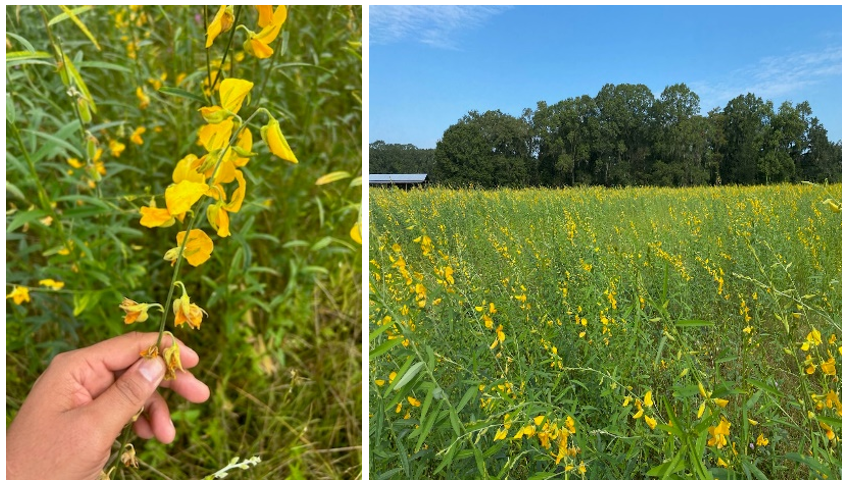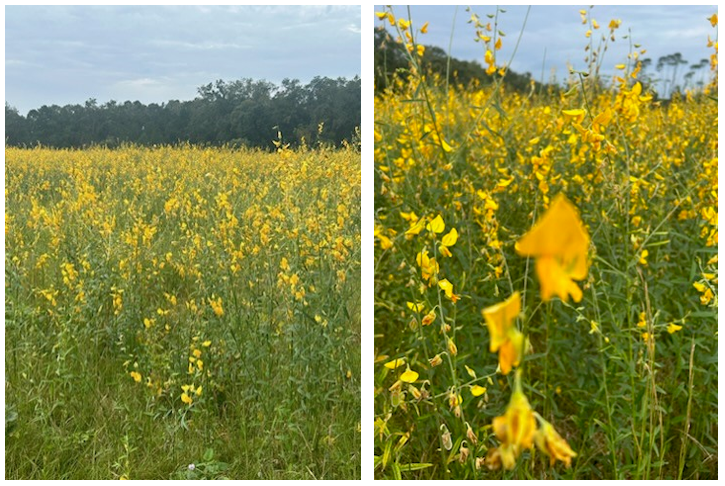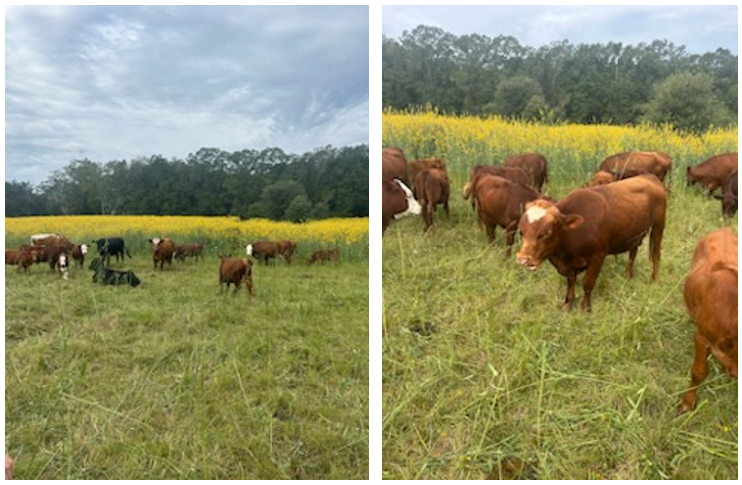De’Anthony Price, Agriculture & Natural Resource Agent, UF/IFAS Extension Jefferson County
Sunn hemp (Crotalaria juncea L.) is a warm-season, annual legume native to India and Pakistan. The crop grows up to nine feet tall and was originally a fiber crop. In Southeast Asia, sunn hemp has been grown as a green manure crop and is now cultivated in many tropical and subtropical regions worldwide. Sunn hemp seeds are mainly produced in India, Hawaii, Colombia, and South Africa. In the US, sunn hemp has been cultivated as a summer cover crop in the Southern, Mid-Atlantic, Pacific, and Northern Great Plains states. Flowering is triggered by short daytime length, but an appropriate temperature is required for a complete seed set. Therefore, sunn hemp cannot produce seed commercially in most US states except Hawaii. Under the South Florida climate, sunn hemp can produce prolific flowers, but seed setting is low due to the inappropriate temperature associated with the daytime length. Until recently, the use of sunn hemp has been limited by seed availability. However, newer varieties (i.e. AU Golden and AU Darbin) that can produce seed in temperate climates have been bred. Crotalaria juncea and Cannabis sativa are both plants grown for fiber production, which is why they are called “hemp.” However, sunn hemp (C. juncea) is a legume from India, while C. sativa is a non-legume from China. Sunn hemp does not produce cannabinoids, while hemp does.
–
Sunn Hemp Establishment
Sunn hemp is an annual crop, so it must be started from seed each year. Once the soil temperature has reached 65°F, sunn hemp can be planted into a prepared seedbed. Lack of water during the establishment phase can affect germination, plant density, and growth. If rainfall is insufficient, irrigating from seeding until two weeks after germination will help. Plant at 25 to 30 pounds of seed per acre and inoculate with a cowpea-type inoculant. Seeding depth is ¼ inch to 1 inch. Due to its wide tolerance of soil pH, liming is not required but is recommended. Nitrogen fertilizer requirement is minimal as sunn hemp is a legume, but phosphorus and potash should be added based on soil test results. As a legume, sunn hemp forms symbiotic relationships with rhizobia in the soil, which fixes atmospheric nitrogen into plant-available forms. This minimizes the nitrogen requirement for the crop. Fertilizer at a rate of 30 lb/acre of N, P2O5, and K2O can be applied after germination to facilitate faster growth.
Sunn hemp grows best in sandy, well-drained soils. It is not tolerant of standing water or heavy clay soils. In the first 30 days after planting, the plant will have little above-ground biomass production. However, by day 60, plants can be six feet tall. Plantings of sunn hemp can be staggered (May and July) to maximize the length of the grazing season. This allows for a higher quality forage throughout the grazing season and into early fall.
–
Sunn Hemp as a Cover Crop
Cover crops are plants that keep the soil “covered” during non-crop growing seasons. Cover crops are planted primarily for their agro-ecosystem benefits rather than for harvest. The list of potential cover crop benefits is long. A wide variety of cover crops can be used in Florida. Species such as cereal rye, oats, and crimson clover are commonly used during winter fallow months. In the summer, sorghums, millets, cowpeas, and sunn hemp are often used. The “best” cover crop depends on several things: soil, climate, planting time, what benefit you want, and the equipment you have to plant the cover crop and manage the residue. Farmers and gardeners use cover crops to prevent erosion, increase soil organic matter, prevent nutrients from leaching below the root zone, provide nitrogen from legumes, provide habitat for beneficial insects, and promote soil microbial activity and diversity.
–
Sunn hemp increases rotational crop yields and reduces invertebrate pest pressure. Sunn hemp residue adds nutrients and organic matter to the soil and may enhance soil microbiota. Most studies of vegetables planted after sunn hemp have found increased vegetable yields. Sunn hemp also suppresses weeds and nematodes. Its residue contains plant defense compounds, called allelochemicals, that inhibit or delay the germination of weed seeds and the life cycle of nematodes.
Sunn hemp is often mixed with sorghum sudangrass. Sorghum sudangrass uptakes excess nitrogen from the soil to produce biomass with a high C:N ratio. The mixture of plants can increase overall biomass and diversity, which benefits nutrient cycling and soil microorganisms. Sunn hemp can also be mixed with other legumes, such as American joint vetch, cowpea, and hairy indigo. The smaller stature of northern varieties, such as ‘AU Golden’ and ‘Ubon,’ may benefit multi-species covering crop mixtures.
–
Sunn Hemp Grazing Management
Some varieties of sunn hemp produce harmful alkaloids (most highly concentrated in seeds), while others are non-toxic and make excellent forage. ‘Tropic Sun’ is a standard variety safe for animal feed. ‘AU Golden’ and ‘AU Durbin’ have high leaf quality for livestock feed (25–30% crude protein). Sunn hemp can be grazed by cattle, goats, and sheep. Grazing should start when plants are 1.5 to 3 feet tall, approximately 45 days after planting. The leaves are of high quality, but the stems are not. However, the stems provide the fiber needed for proper rumen function. Maximizing the leaf-to-stem ratio is essential to maintain forage quality. A field allowed to grow until flowering may lose lower leaves and have decreased forage quality due to a lower leaf-to-stem ratio. When the field is at 80% bloom, only 35% to 40% of the biomass is leaves.
–
Early grazing is essential to ensure forage quality. Rotate livestock from the field once the forage reaches 12 to 18 inches. Due to its high quality, sunn hemp is well suited for limit grazing in combination with warm-season perennial pastures. It is suggested to graze between 1-3 hours a day. At first, livestock may not find sunn hemp palatable, but within one to three days, they will develop a taste for it. If sunn hemp is grazed too early, livestock will over-graze, possibly killing it. If plants are grazed above 6 feet, the livestock will break the plants and will not regrow. Mowing or grazing sunn hemp to less than 12 inches can also prevent plant regrowth. Managing sunn hemp for hay or silage can be challenging due to the size and fiber levels of the stalks, so grazing is the preferred management option.
–
For more information on Sunn Hemp, use the following publication links:
Questions and Answers for Using Sunn Hemp as a Green Manure Cover Crop
Sunn Hemp—A Promising Cover Crop in Florida
Grazing Sunn Hemp
- Tips for Transitioning to an Organic Cropping System: Soil Health - March 1, 2024
- Jefferson County 2024 Beginning Beekeeping Series:January 13-February 10 - December 20, 2023
- Sunn Hemp: The Yellow Hemp Forage - October 13, 2023



